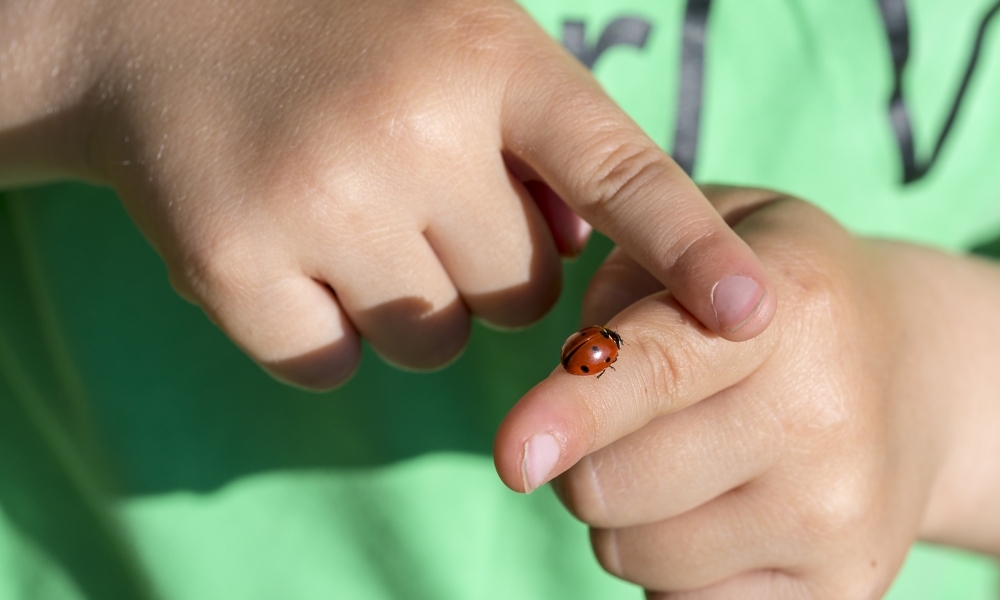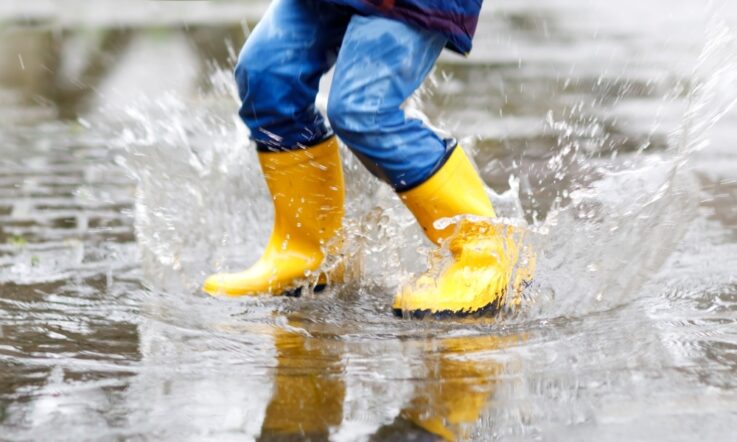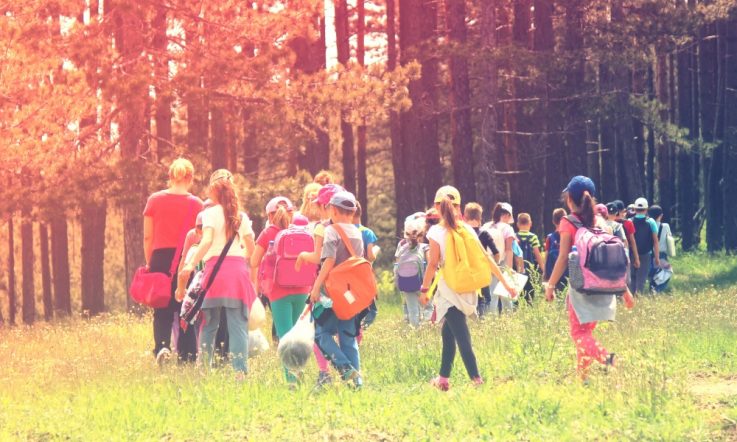Hello and thanks for downloading this podcast from Teacher – I’m Jo Earp.
My guest on today’s episode of The Research Files is Professor Amy Cutter-Mackenzie-Knowles, Executive Dean of the Faculty of Education at Southern Cross University and Project Leader of the Childhood Nature Play study. Now, the research team has been working with young children and their teachers to record their everyday nature play and its links to STEM learning. That information has been used to co-design evidence-based nature play experiences and a pedagogical framework called Mudbook. I’ll be talking to Amy about nature play in education settings, the aims of this particular research study and some of its key findings. And she’ll also be sharing details of some of the teaching and learning resources that have been produced. And a note that there might be a little bit of background noise at times in this one, from a dog that joined the podcast recording!
Jo Earp: Professor Amy Cutter-Mackenzie-Knowles, welcome to The Research Files. As I said in the intro there, you and your team have been researching young children’s experiences and educators’ conceptions of nature play as well. What does nature play look like around the world, and what did it mean in the context of this study?
ACMK: Thanks for having me, it’s a pleasure to talk with you today. In terms of what does nature play look like around the world – it’s not a new concept, but it has been given a lot of energy over the last 10 years. Early childhood education very much has its roots in nature play with the word kindergarten meaning ‘child’ and ‘garden’, it’s a German word and comes from Friedrich Froebel.
But, in the last 10 years even now moving up to 15 years there has been this rapid resurgence in supporting open, free nature play in [education settings]. And the reason for that has been because there’s been this [observation] of a decline in children’s experiences in nature. And then the repercussions of that, in terms of increased anxiety, depression, lack of physical activity, sedentary behaviour and so on and so forth, as well as research showing the benefits of time in nature, noting that human beings are indeed nature. So, of course we have that natural affinity and connection.
And so, over the years, some of your listeners might remember there is an author called Richard Louv and he talked about children suffering from nature-deficit disorder, from essentially that observation of having not enough time in nature. I don’t quite see it that way, I don’t see children as deficit in that respect at all, but I do see that they are in very much a changing set of circumstances where they have far more time on screens, far more time inside, therefore on screens. And so their environments in some ways have opened up where there is this kind of interplay of virtual environment versus the natural environment, and it’s, too much of anything is probably never a good thing, which sometimes screens can certainly do.
So, in that sense there’s been an active interest in understanding what children learn through nature play, not just in terms of what are the benefits physically, socially, but what are the academic benefits. And for us that was the real interest point – what are the actual academic benefits of nature play and, specifically, their scientific understandings.
JE: So we did a podcast with Claire Warden where we talked about the forest schools in Scandinavia and the examples in the UK, including the nature kindergartens in Scotland that she founded. With this study then, am I right in thinking it wasn’t necessarily those full-on nature schools, but some of it was just going outdoors and doing study, taking walks and so on?
ACMK: That’s right. This particular study involved 20 early childhood settings across Queensland, and there were 10 settings in Southeast Queensland and 10 in Central and North Queensland. There were some settings where they are 100 per cent outdoors, but there are other settings where they are on the fourth level of a high rise building in Surfers Paradise. And so there was an absolute range of different early childhood settings across the study. What we were wanting to do is really understand, well what does nature play look like across all these settings – not only in, for instance, in a nature play-intensive early childhood centre, for example. And that allowed us to do that through having that diversity.
JE: And this research study is interested in the experiences of early years students – specifically, though, how they learn scientific concepts through nature play. We’ll talk about some of those concepts in a moment, but why was the focus on STEM learning, why focus on science?
ACMK: [I guess] there are two reasons for focusing on STEM. One that it’s absolutely critical in terms of our future as a planet and how we understand the world scientifically, but also because there is a serious lack of research around this area of really understanding, well what are children’s scientific concepts through nature play? We do understand that more and more through work like Marilyn Fleer’s around Play Lab at Monash, but not so much in a nature play setting, or even incorporating nature play pedagogies. So they were the two primary reasons – one, there’s a serious lack of research around this, but two there’s an absolute priority for early childhood education and education broadly and in Australia to really, I suppose, up the ante in STEM education.
JE: You’re Executive Dean of the Faculty of Education at Southern Cross University. But this was a joint research project involving SCU, there was RMIT University, Swinburne University and then several other partners, including Nature Play QLD and the Early Childhood Teachers’ Association, and of course all those settings as well. How many children were involved in the study? And, when I say involved you really did want them to take on an active role as ‘researchers’, didn’t you?
ACMK: That’s right, so there were the 20 settings and then 152 children involved across all of those settings, and 31 teachers involved. For us, getting to their role, the methodology involved a number of phases and the second phase was really working with the children as researchers where they were given a tablet to essentially document their play and learning across a week, in their community, in their early childhood setting, at home and it was quite simply put to them –document your nature play and what you see as nature play. And it was quite fascinating, there were so many videos of children in a bedroom, for instance, with a ladybug on their hand and filming it crawling all over their body. It wasn’t necessarily outside, there was a really strong mix of inside activities, inside play, as well as outside play.
JE: The other thing I’ve seen in your sharing of some of the findings is that used a research methodology called cartography – can you just explain a little bit about that for our listeners.
ACMK: Well, cartography is essentially, it’s a post-qualitative methodology. But cartography is a map – so ‘carte’ is French for ‘map’. And it’s around really not just understanding children’s, for instance, scientific conceptions, but it’s really about mapping them as well. So that next step of seeing ‘well, what are their ideas, the concepts across the entirety of the group?’. And so, for us, we were wanting to develop that complexity around the mapping of practices but also understandings and conceptions.
JE: So, the project revealed that there are nine types of nature play. Can you take us through some of those?
ACMK: Sure, so I’ll go through a couple of them. There’s ‘death play’ and that was a really common type of nature play which in some ways was a little surprising, but also unsurprising as well because death is part of life and so children were quite fascinated in that concept of death in animals. It’s often the first experience that children have of grief, is the death of an animal.
For many children it looked different though. So, for instance at one of our sites at Birdwings Forest School – so that’s a setting where they were 100 per cent outdoors – they observed a dead kookaburra over a six month period and so there was quite fascinating conversations that we observed around decomposition over that period and seeing really the kookaburra going from being looking like it’s asleep to being bones. And the children’s fascination over that period around the concepts and what was happening, including things like who was eating the kookaburra and what were the next steps – even stories around spirit of the kookaburra, to cultural myths and stories … to there were other examples in other settings where they came across a dead snake and looking closely at that, to others where the pet goldfish died. And so that was quite surprising I guess, in term of its commonality as a common nature play pedagogy and this really important conversation around death and grief, which I think is fair to say in western countries we’re not always so great at those conversations. And so it was quite heartening to see that happening in that sense, both from a scientific point of view, but cultural.
In terms of some other types of nature play, so there was ‘slow play’ or ‘slow nature play’ and that doesn’t… what that meant is and what we often observed there and the kookaburra story I just told is a good example of that as well, where it happened slowly over time, but it’s also over seasons as well. Having long periods of time so that you can actually observe the seasons, but also what’s happening in that place over that time, but also in the moment as well. I saw so many experiences where a child would be deeply engaged in investigating a puddle, for example, and not kind of splashing and jumping up and down all through it but actually really observing what’s happening in there. And that’s what I mean, it’s a bit like the slow food movement, is really slowing learning down, which I think is so important in such a fast-paced society that we do that. And nature play again affords for that to happen.
JE: Did you do any thinking about why these experiences in particular support learning, as opposed to say just watching a video, or even watching a video every week of something happening over time? I’m just wondering, is it sort of that sense of awe and wonder? What is it about nature play itself?
ACMK: We did. I think it’s about being in the experience itself. You can, for instance, watch the decomposition in fast time of a dead kookaburra over probably a minute, but it really says something when you actually watch in real time over six months as part of your other pedagogies, like walking. With these groups of children that’s what they would do every day, is go on these walks so they would see the dead kookaburra every day. So in that sense it’s about having experiences that perhaps you’ve never had before, and when you’re watching from the periphery of a video, it’s not really your experience, you’re watching the experience of another – and that can be enjoyable and you might take something from it.
But as we know, and we’ve known for hundreds of years through work like John Dewey, that the powerfulness of that in-person experiential learning and then having profound impacts on ultimately who you come to be. And a lot of children … and when you talk to for instance environmental scientists, scientists, about ‘what were some of your profound experiences that led you to being a scientist?’ for example, and they’ll talk about things like this – that it was being out on trail, or it was camping with their family, or they’ll talk about profound forest school experiences, or they’ll remember some of their earliest memories of being in nature and building a fort or engaging with it in some way and relating. So I think that’s why it’s so critical.
JE: Yeah, and of course, there’s lots of links to science there in terms of the curriculum and those foundations for things they’re going to learn later on. So, the other thing I wanted to touch on is Indigenous culture and you mentioned that with the kookaburra and the spirit stories and so on. I understand that several of the education settings that you worked with in the research project were Indigenous-focused?
ACMK: And we called that ‘country play’ – ‘in place’ or ‘country play’. And it wasn’t just a matter of doing, for instance, a simple acknowledgement at the beginning of each day or the beginning … in terms of at the setting, it was then what was so beautiful to see in many respects with regards to where Indigenous education is evolving, was we would see it then enacted in the children’s play.
So, for example, like I talked before about the child who might be looking in a puddle and investigating all the different life in there and let’s say then (and I observed this) the child says ‘oh, I might take this rock with me home’ and then seeing another child say ‘well no, because we made a promise at the start of the day that we were paying respects to our past and present descendants upon the land but also the land itself and the environment itself, and so you would be breaking your promise’. And so, seeing it enacted, interactions between child to child and child to adult, it was a constant.
And I think that’s so important, is seeing that it’s actually about a different type of relationship. It’s a relationship about being in balance, or in relation, with the land or with the environment and seeing that these really young children, as young as three, four and five, understood that – where I see a lot of adults don’t understand that. … We observed that across a number of sites, which I hadn’t seen that acutely before, not to that extent, to the extent of it being so solidly situated at the centre of their practice and where they’ve worked with local Indigenous Elders and community in getting their practice to their point, where it wasn’t just something that just happened overnight, it had been a relationship over a very long period of time.
JE: And what’s exciting is the other thing that’s come out of it of course has been sharing what’s been learned during the project and how that can benefit teachers and leaders in the early years of schooling and perhaps beyond as well, into older age groups. I’m sure there’s lots of educators listening to this that’ll be keen to find out more about strategies and activities they could try out. You’ve produced a series of resources haven’t you?
ACMK: We co-designed the Mudbook (PDF, 13.2MB), which is a nature play pedagogical framework, and that was developed with and for teachers. And so, throughout it, there’s many examples of practice which, I know as a teacher myself is certainly there’s nothing quite like that hearing from teachers in their words or children in their words about their own practice. So there’s many suggestions in there, including around what some of the barriers are, some of the risks and so forth, and how some of these different settings have come at that.
And all of the settings in the Mudbook wanted to be clear in identifying their setting and the name of their setting because they very much see it as a community. And, like we do very well in education and schools and early childhood is simply reach out to them – if there is a particular setting and that practice really resonates with you I would encourage you to reach out to them as well. And we do have a Facebook site, and a website and Instagram where you can make those connections as well.
JE: We’ll put some links in the transcript of this podcast on the Teacher site, just head over to teachermagazine.com and click on the podcasts tab or just search for ‘nature play’. Are these activities and ideas transferable to older age groups – so, if you’re teaching in say Year 2 … is this something that could be adapted?
ACMK: Absolutely. Forest schools has been happening now for a long time, like you mentioned before in Scandinavian countries and in the UK and its really being taken up all over the world and that’s certainly happening in Australia too, with forest schools and bush schools.
So it’s not new to schools in that respect. But, where it is somewhat newer is where it becomes an everyday pedagogy – that it’s not something that’s just special that you do once a week or once a month, and where it becomes integrated and embodied into the actual everyday practice. And that’s something that I think is less understood in Australian schools. So that’s a particular area of research that we’re now looking to really open up and explore further and how it could really look on an everyday basis, for instance, in upper primary and secondary.
As I said, it’s not like there’s nothing happening, there’s a lot happening, but where researchers can really help is helping to join the dots there. Like we’ve done in this research project, where we’ve essentially been able to really profile practices across 20 different centres and how nature play looks in that regard, and we’re looking to do something similar with schools.
JE: That’s great. Well, the project has moved things forward in terms of our own understanding of nature play and as ever we wish you luck with the research expansion in the future. Amy Cutter-Mackenzie-Knowles, thank you very much for sharing your expertise with Teacher.
ACMK: Thank you for having me. It’s been a pleasure, thanks Jo.
That’s all for this episode, thanks for listening. Watch out for next week’s episode of Teacher staffroom, where Dominique Russell will be taking you through content from November to catch you up on the latest evidence, insight and action. Subscribe to our podcast channel on Apple podcasts, Spotify or SoundCloud, or wherever you get your podcasts from to receive a notification when any new episodes drop, and a reminder that you can also access the 200+ that are already in our archive. I’ve also got a quick favour to ask – while you’re there, we’d really appreciate it if you could rate and review us.
References
Cutter-Mackenzie-Knowles, A., Osborn, M., Lasczik, A., Malone, K., & Knight, L. (2021). Mudbook: Nature Play Framework. Queensland Government Department of Education.
In this podcast, Amy Cutter-Mackenzie-Knowles talks about nature play being integrated into everyday practice, rather than a special thing you do once a week or once a month.
How often do you give students the opportunity to explore, play and learn in nature? Lots of the examples in this study were of children enjoying inside nature play, as well as outside. How could you incorporate inside nature play into your own classroom practice?



